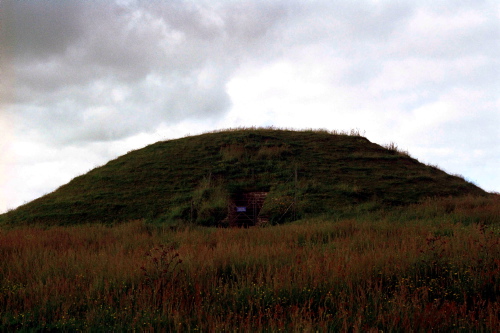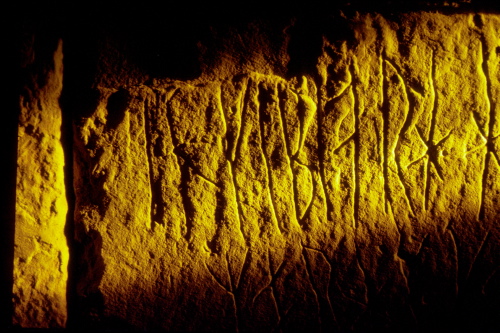Maes Howe Burial Chamber
Maes Howe (or Maeshoe) is a burial chamber on the mainland Orkney, built around 3000 BC. Though not from the viking period, it is of particular interest because of the examples of Viking grafitti on the walls.
During the 12th century, Viking groups broke into this prehistoric tomb and carved 30 inscriptions into the walls. They left runic graffiti telling of their exploits, including descriptions of treasure, crusaders and beautiful women as well as carvings of animals on the walls.
In 1861, when the burial chamber was being excavated, it was impossible for the archaeologists to get into the original entrance passage, so instead they had to cut a shaft from the top of the mound. They soon realised that they were not the first to have broken into the tomb. All over the walls in the central chamber were these runic inscriptions.
Maes howe is one of the largest and most famous collections of runes found in Europe. The discovery at Maes Howe has confirmed what had been written in the Orkneyinga Saga. According to the story, a group of Harald Maddadson's men had tried to take over Orkney in 1150, while Earl Rognvald had gone off crusading. The raiding party had taken refuge in Maes Howe from a violent storm, as they made their way from Stromness to Firth. As they waited for the storm to blow over, the men amused themselves by carving graffiti into the walls of the tomb. The second break-in to this ancient burial chamber was in 1153, when members of Earl Rognvald's party returned from their Crusades.
Inside Maes Howe burial chamber there is a 9 m long passage, which leads to a wide main chamber, with three side-cells. The entrances to the side-cells are above floor level. The directions of the passage points to the midwinter sunset, and in December the sun shines into the chamber. The Viking graffiti comprise 30 runic inscriptions and on a corner pillar three engraved figures; a dragon or a lion, a walrus and a knotted serpent.
Writings on the walls
Some of the inscriptions talk of treasure. Examples include; 'It is long ago that a great treasure was hidden here'; 'Happy is he who might find the great treasure'; 'Hakon alone bore the great treasure out of the mound'. Others inscriptions show names of the men, boastful tales of their exploits and jokes.
Some of the graffiti are rather amusing; 'Ingigerth is the most beautiful of all women'. This was carved alongside a rough drawing of a slavering dog. Other examples include;
Fact: Maes Howe is not the only prehistoric monument to have been marked by runic graffiti. One of the stones of the 'Ring of Brodgar' has also been marked by the Vikings.
Monica Callaghan, Hunterian Museum & Art Gallery, University of Glasgow

